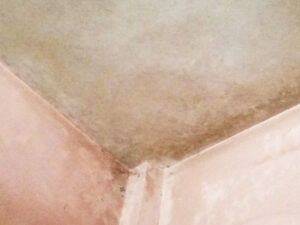Cat owners know that cat spray is an unfortunate byproduct of owning cats. Unfortunately, it’s often difficult to avoid. While this problem is common for all cat owners, if it happens on freshly painted walls it can become annoying quickly. If left alone it could leave an unpleasant lingering scent and possibly stain the walls permanently.
Cleaning cat spray off painted walls takes some effort, but can be achieved effectively using the appropriate tools and methods. There are both DIY options and commercial options that may work. Each has its own advantages and disadvantages so it is essential that you find what best works for you and your situation.
In this article, I will discuss different techniques to remove cat spray from painted walls in various ways. I will go over what to do and not do when cleaning up cat spray as well as provide step-by-step instructions for getting the mess cleaned up quickly. No matter if it’s fresh spray or old stain. This guide provides all the tools and information to get your walls back to looking like they used to!
How to Clean Cat Spray Stains Off Painted Walls in 5 Easy Steps
Cat owners may find cat spray offensive and unpleasant when it lands on painted walls. Cat spray has a strong, pungent scent that lingers and could leave permanent stains behind if left alone. Here are five easy solutions for getting rid of cat spray stains on painted walls.

Step 1: Prioritise Safety first
Before beginning to clean, it’s essential that you ensure you’re safe. Cat spray can contain dangerous germs that could compromise your health. To protect both skin and lungs it’s wise to wear gloves and a face mask while also covering any cuts or scrapes.
Step 2: Assemble Your Cleaning Equipment
Collect all your cleaning tools. There are both DIY and store-bought solutions, each offering its own advantages and disadvantages. Some common products for household cleaning include:
Vinegar (white or distilled), baking soda (baking powder or plain), hydrogen peroxide and enzyme cleaners may all work to effectively clean. There are even pet marks and odor removers you can purchase. No matter which solution is used to clean, always have plenty of paper towels handy, along with a brush/cloth and warm water in a bucket for best results.
Step 3: Eliminate any stains first.
Before beginning to clean up cat spray damage, you need to treat the area first. This will help break up and eliminate spots more efficiently. White vinegar may serve as an effective pre-treatment.
Follow these steps to pre-treat a spot with white vinegar:
Mix equal parts white vinegar and warm water in a spray bottle. Next, Spray onto cat spray marks for 5-10 minutes before waiting to apply them to surfaces. Use a paper towel to absorb excess liquid in the area. For harder-to-treat cat spray stains, combine enough water with baking soda to form a dough. Apply it directly onto the spot, let sit for 10 to 15 minutes, and remove using damp cloths.
Step 4: Eliminate the Spot
Once the cat spray stain has been addressed, it’s time to tackle cleaning it. Depending on its severity, there may be different approaches available to you for effective removal.
- Method 1: Hydrogen Peroxide Solution
Hydrogen peroxide is an excellent cleaning product to use against cat spray spots. Here’s how you can do just that with hydrogen peroxide:
Blend equal parts hydrogen peroxide and warm water in a spray bottle and use this solution on any marks left by cat spraying. Clean gently using a sponge or cloth. Rinse with warm water before patting dry with a paper towel.
- Method 2: Opt for cleaners that contain enzymes
Enzymatic cleaners are specially formulated to tackle organic spots like cat spray. Their enzymes work quickly to eliminate smell and break down spots on surfaces, providing an efficient means of eliminating them. Follow these steps for using an enzymatic cleaner on cat spray spots:
Spray an enzyme-based cleaner directly on any cat urine spots. Allow it to work for 10-15 minutes before gently scrubbing with a sponge or cloth and rinsing with warm water, followed by patting dry with paper toweling.
- Method 3: Commercial products
Commercial cleaners for pet stains and smells are designed to eliminate these problems quickly and efficiently. Available both at pet stores near you as well as online. Simply follow these steps when cleaning cat spray spots using one of these commercial stain and odor removers:
Read and follow all instructions carefully on the package, then apply the product directly onto the target area from a cat spray. Allow it to sit there for the time indicated and scrub gently using a sponge or cloth before rinsing with warm water, and patting dry with a paper towel.
- Method 4: Mix dish soap with warm water
Dish soap is an effective solution for eliminating cat spray spots on painted walls, following these steps for cleaning a cat spray spot with dish soap:
An effective cat spray removal method involves mixing small amounts of dish soap with warm water in a spray bottle. Apply this solution directly to any affected areas. Once applied, use a sponge or cloth to gently scrub over the area until its cleaning action takes effect. Rinse out and pat dry the area using a paper towel afterwards.
Step 5: Reiterate as necessary
Don’t fret if a cat spray stain remains after cleaning it once. It may take multiple attempts before getting all of its colors off the fabric. Simply repeat the cleaning process until all spots have vanished from sight.
If cat spray has been present for an extended period, it could have made its way deep into the paint and drywall. It caused permanent staining that cannot be completely eliminated. In these instances, painting over damaged areas might be necessary.
Overall, cleaning cat spray marks off painted walls is no easy feat. However, following these 5 easy steps and using appropriate cleaning tools will allow you to clear away cat spray stains from your walls and restore their appearance. Remember to remain safe, treat the spot prior to beginning cleaning, and repeat as necessary. With time and hard work, your walls will once more be fresh-looking and smell nice!
Can vinegar be used to clean cat spray from painted walls?
Vinegar may be used to effectively clean cat urine off walls that have been painted. Providing an efficient means of removing cat spray marks from surfaces that have been recently painted.
Vinegar is a common household cleaner, often employed to clean surfaces such as painted walls. But vinegar may not be the ideal solution to eliminating cat spray spots on these walls.
Vinegar is an effective natural cleaner, helping to eliminate smells. However, it may not be powerful enough to fully eradicate cat spray stains as this material contains pee and pheromones which are hard to wash away.
Vinegar is an acidic solution, meaning that using too much or incorrectly can have negative consequences for the paint on your walls. Overexposure or incorrect use could cause it to fade or peel over time.
If you decide to use vinegar to clean cat spray spots off painted walls, it is wise to dilute it with water and test a small, concealed area first before proceeding further with this solution. This will enable you to determine whether or not the solution is safe to use on your paint type.
If you want a quick way to remove cat spray stains on painted walls, cleaning products specifically made for this task are an effective solution. Most often these contain enzymes and other powerful cleaners that will quickly get rid of cat spray stains without harming the walls themselves.
Overall, vinegar can be an effective and safe solution for cleaning certain items. However, for cat spray spot removal on painted walls, it may not be. For optimal results, it is wise to select a way that provides both results and safety for the walls being cleaned.
Also Read: Simple Steps to Clean Your Concrete Basement Floor and Walls: Get Your Basement Looking New Again
Will bleach damage my painted walls if I use it to clean up cat spray?
Bleach is an effective cleaner that can eliminate stains and smells quickly, yet if it is misused it could damage painted walls. Since bleach is an acidic solution it could alter its color, fade over time, and peel at its touch.
Care should be taken when using bleach to remove cat spray spots on painted walls. Avoid applying straight bleach since this could potentially harm the paint job. Rather, mix bleach with water first and test it in an inconspicuous part of your wall to make sure it won’t cause damage.
Bleach can be dangerous to your health if used incorrectly. It can damage both lungs and skin and, if consumed by accident, become toxic. Therefore, when handling bleach it’s vital that gloves and safety gear are worn while making sure there is sufficient airflow within the area in which you’re using it.
If you want an effective solution for getting rid of cat spray stains on painted walls, there are cleaning products specifically tailored for this task on the market. Most often these products work by breaking down enzymes and bacteria found in cat spray, which effectively eliminate the mark and smell without harming your walls.
Overall, bleach can be used to get rid of cat spray spots on walls; however, care must be taken in its use and only once it has been diluted with water. For maximum effectiveness and safety considerations when cleaning walls with bleach solutions.
Are old cat-spray spots on painted walls removable?
Cat spray marks on painted walls may be difficult to remove, but it is possible with the appropriate tools and methods. The longer that cat odor and germs have had time to seep deep into the paint layer, making removal harder.
Utilizing an enzymatic cleaner is one of the best ways to get rid of old cat spray spots on painted walls. These cleaners work by breaking down germs and enzymes present in cat spray, eliminating both staining and smell from walls. Make sure that you carefully follow any directions given for each cleaner’s usage on specific spots for the optimal result.
Baking soda and water can also help you remove old cat spray spots on walls. Simply apply it directly and let it set before wiping it off with a damp cloth after some hours have passed. Baking soda’s natural deodorizing qualities also work to eliminate wall smells quickly.
If the stain is particularly stubborn, you may need to use a scraper or sandpaper to carefully peel away the top layer of paint from the wall. Be mindful not to further damage its integrity during this process!
Overall, it can be challenging to remove old cat spray spots from painted walls. However, with the appropriate tools and methods it is possible. Enzymatic cleaners or baking soda can both help eliminate the stain and smell issues. For particularly stubborn spots you could use scraper or sandpaper.
How long does it take for cleaning solutions to remove spots caused by cat spray?
How long it takes a cleaning solution to work against cat spray stains depends on several factors. Including its type and strength, age and seriousness of stain as well as the type of surface being cleaned.
Enzymatic cleaners are among the best methods for eliminating cat spray spots, though their efficacy may take some time to take effect. How long it takes will depend on both what kind of cleaner you choose and the severity of the spot. Some enzymatic cleaners may work within minutes, while others might take hours or even overnight before being effective.
Baking soda can also help remove cat spray spots but may take some time. For best results. Mix baking soda and water in equal parts and let the paste set before wiping it away after several hours.
As a rule, patience should be the watchword when trying to rid yourself of cat spray spots. Rushing could result in not extracting all the color or even damaging the surfaces you are cleaning. Thus it is wise to carefully read instructions for cleaning solutions and allow them to work for as long as suggested before wiping them away.
Overall, the length of time it takes a cleaning solution to work its magic on cat spray spots can vary, but for optimal results, it’s essential that you be patient and follow instructions precisely.
Can I use a power washer to remove cat spray stains on painted walls caused by cat spraying?
Pressure washing might seem like an attractive solution for cat spray spots on painted walls, but this approach should be avoided. Pressure cleaning involves spraying a strong stream of water over surfaces that have been painted. This may cause paint to flake off or cause further damage to walls that have already been painted.
Pressure washing alone might not remove all of the germs and enzymes found in cat spray that creates its stain and smell. In fact, without adequate cleaning agents available on-board your power washer it could actually worsen or even spread them further into your paint surface.
Instead, use a cleaning product specifically formulated to eliminate cat spray spots on painted walls. Enzyme cleaners or baking soda solutions work effectively at breaking down germs and enzymes present in cat spray without harming the paint job.
If the stain is particularly stubborn, using a scraper or sandpaper carefully to peel away its uppermost layer will help ensure no further damage to the wall occurs. Do this carefully so as to not cause further disfiguration to it.
Pressure cleaning might appear like an effective and straightforward method for eliminating cat spray stains on painted walls, but it should not be seen as such. Instead, using an appropriate cleaner is safer and more effective in getting rid of both staining and smell without harming the paint on your walls.
What should I do if cleaning does not remove cat spray stains from my furniture?
If cat spray spots refuse to fade even after being carefully cleaned, there are a few strategies you can try.
First, explore different cleaning solutions. Some cleaners may work better at eliminating certain stains than others. Enzyme cleaners tend to work best at getting rid of cat spray spots, but if that doesn’t work you should switch it out and give another a try.
If the spot is difficult to remove, you may need to repeat cleaning it more than once. Be sure to read and follow all directions on the product you use for cleaning. Allow its solution to sit on it for as long as directed before wiping it away.
If the stain refuses to come off, more extreme measures might be needed; such as sanding or repainting. But this should be considered only as a last resort as this could potentially cause permanent damage to walls, leading to larger problems that need fixing later on.
Professional cleaning or repair services may be required in certain instances, as they possess special tools and products designed to remove even the toughest of stains.
At the core, the key to managing cat spray marks is prevention. This may mean correcting any behavioral issues your cat may be having such as showing its territory or taking steps to keep him away from locations where it tends to spray. Stains can worsen over time without regular care being provided;
Final Thoughts
While cleaning cat spray from painted walls may be frustrating and time-consuming, there are effective and simple solutions available. Enzymatic cleaners and baking soda solutions are two effective strategies that will remove spots deposited by cat urine. Just be patient while following all directions carefully!
Keep in mind that cleaning solutions may remove cat spray spots but may not completely eradicate the smell. In these instances, additional odor-removing goods such as air purifiers or absorbers could help.
Stopping your cat from spraying can only be accomplished through prevention. Treating any behavioral issues could reduce the likelihood of spraying again, while failing to address stains regularly could only exacerbate them over time.
Although it might be tempting to resort to harsh methods of cleaning like pressure washing and sanding. They should be avoided as these could damage the paint on walls. If cat spray spots prove difficult to eradicate, contacting professional restoration services might be the way forward.
Overall, with some patience and the appropriate steps in place, cat spray spots from painted walls can be removed, and your home returned to its former look.







